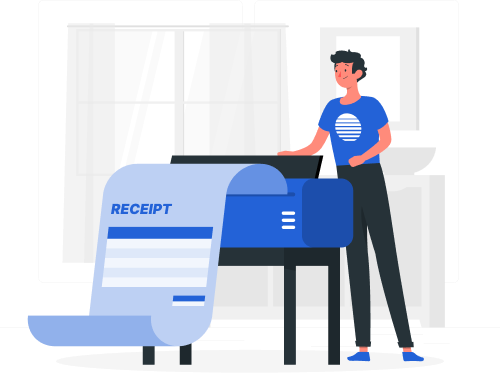Tips
What is an Itemized Receipt? Its Importance for Expense Tracking

The creation and organization of itemized receipts have evolved. Businesses and individuals alike are transitioning to digital tools that allow for easy storage and retrieval of these documents, enabling them to streamline their financial processes. Understanding how to effectively utilize itemized receipt can enhance both financial oversight and compliance in various sectors.
With the growing emphasis on accurate record-keeping, becoming familiar with itemized receipts is increasingly important. From understanding their components to utilizing digital solutions for better management, knowledge of itemized receipts can aid in achieving clearer financial insights.
Key Takeaways
- Itemized receipts provide detailed information on purchases, aiding in expense tracking.
- Digital tools simplify the creation and management of itemized receipts.
- Effective use of itemized receipts enhances financial transparency and organization.
What is an Itemized Receipt?
An itemized receipt is a type of receipt that breaks down a transaction into individual items or services purchased. Unlike a standard receipt, which simply lists the total amount, an itemized receipt provides specific details about each item, including prices and quantities.
Itemized receipts serve a vital role in both personal and business financial management. An itemized receipt provides a detailed breakdown of each item purchased, including prices, quantities, and applicable taxes or discounts.
This clarity not only helps consumers keep track of their expenses but also ensures businesses manage their accounting accurately and transparently.
The primary purpose of an itemized receipt is to offer transparency and clarity in financial transactions. This makes it easier for consumers to track expenses and for businesses to manage budgets. They also facilitate reimbursement processes for employees and can be critical for tax deductions.
Components of an Itemized Receipt
An itemized receipt typically includes several key components:
- Date and Time of Purchase: Indicates when the transaction occurred.
- Vendor Information: Includes the name and address of the seller.
- List of Items/Services: Details each item or service bought, often including:
- Description: What was purchased
- Quantity: How many were bought
- Unit Price: Cost per item or service
- Total Cost: Total price for each item
- Taxes and Additional Fees: Any applicable sales tax or additional charges should be clearly stated.
This format provides a clear account of what was purchased, which is essential for effective expense tracking.
How to Create Itemized Receipts
Creating itemized receipts involves specific details and a clear format to ensure both parties understand the transaction. Each receipt serves as a record of purchase, providing proof and details about the items exchanged.
Essential Information to Include
An itemized receipt must contain several crucial elements. First, it should clearly list the buyer and seller’s names and contact information. The date of the transaction is also essential for record-keeping.
Detailed information about each item sold is necessary, including:
- Item Description: A brief name for each item.
- Quantity: How many units were sold.
- Unit Price: Cost per unit.
- Total Price: Total amount for each item (quantity multiplied by unit price).
- Taxes and Discounts: Any applicable taxes or discounts itemized.
These components provide clarity and transparency, ensuring that both the buyer and seller are aware of the specifics of the transaction.
Formatting and Presentation
The format of the itemized receipt plays a vital role in its usability. A well-organized layout enhances readability and comprehension. Typically, receipts should be structured in a clear table format, with columns designated for each piece of information.
Example Table Structure:
| Item Description | Quantity | Unit Price | Total Price |
| Example Item 1 | 2 | $10.00 | $20.00 |
| Example Item 2 | 1 | $15.00 | $15.00 |
Including an identifiable header with the business name or logo at the top can also add professionalism. Additionally, using a consistent font and spacing throughout the receipt contributes to a polished appearance.
Utilizing Receipt Software
With advancements in technology, many businesses choose to utilize receipt software for efficiency. These programs simplify the creation of itemized receipts, allowing users to input information quickly and easily.
Receipt software typically provides features such as:
- Templates: Pre-designed formats to streamline the creation process.
- Customization Options: Ability to add logos, change colors, and adjust layouts.
- Digital Storage: Easy access to past receipts for record-keeping.
Using such tools not only saves time but also enhances accuracy, reducing the likelihood of human error. Businesses that leverage receipt software can create professional and compliant itemized receipts with minimal effort.
Using Itemized Receipts in Business
Itemized receipts play a crucial role in managing business finances. They provide detailed records that enhance expense tracking, simplify tax preparation, and streamline reimbursement processes.
Tracking Expenses
Tracking expenses accurately is vital for any business. Itemized receipts serve as comprehensive records of every purchase, displaying individual items and their costs. This level of detail allows for better budget management and identification of spending patterns.
Companies can categorize expenses, such as supplies, travel, and meals, to generate insightful reports.
By using software or accounting systems, businesses can upload itemized receipts, ensuring all expenditures are documented quickly. Regular reviews of these records can help identify areas for cost savings and improve financial decision-making.
Tax Preparation and Audits
Itemized receipts are essential during tax season and in the event of an audit. They provide proof of expenses, which can maximize tax deductions.
For instance, businesses can deduct costs related to operational necessities, such as office supplies or travel expenses.
Proper documentation reduces the risk of audits by presenting clear, itemized evidence of expenses claimed.
In the case of an audit, having organized itemized receipts simplifies the process and minimizes stress, as it provides tax authorities with the necessary proof without additional delays.
Reimbursement Procedures
Reimbursement procedures are simplified with the use of itemized receipts. Employees submitting expenses can present these receipts for the amounts paid, clearly detailing each item and its cost.
This transparency ensures that employees are reimbursed accurately and promptly.
To streamline this process, businesses can implement policies requiring itemized receipts for all expense claims. This helps prevent discrepancies and maintains financial integrity.
Additionally, using automation tools can speed up reimbursement processes, allowing employees to receive funds faster, enhancing overall satisfaction and trust in company policies.
Itemized Receipts for Consumers
Itemized receipts provide essential details about purchases, aiding consumers in various aspects of financial management and after-sales support. Understanding these receipts can empower individuals to manage their expenses effectively.
Understanding Your Purchase
An itemized receipt breaks down each item purchased, including price, quantity, and any applicable taxes or discounts. This level of detail helps consumers verify that they paid the correct amounts for each product or service.
When examining an itemized receipt, individuals should look for:
- Item Descriptions: Clear identification of each product or service.
- Price per Unit: Transparency on individual costs encourages better spending decisions.
- Total Amount: Confirmation that the total matches what was charged.
Understanding these elements enables consumers to effectively track their spending and facilitates easier budgeting.
Resolving Discrepancies
In case of an error, an itemized receipt serves as crucial evidence when addressing discrepancies with merchants. If a consumer identifies a mistake, having a detailed receipt simplifies the resolution process.
Steps to resolve discrepancies include:
- Compare Prices: Match the prices on the receipt with what was advertised or listed.
- Contact Customer Service: Provide them with the itemized receipt to discuss the issue.
- Follow Up: Keep a record of all communications for future reference.
Being prepared with this documentation can expedite the resolution and increase the chances of a favorable outcome.
Warranty Claims and Returns
When filing warranty claims or returning items, an itemized receipt is often required. It acts as proof of purchase and verifies that the item is eligible for service or return.
Key points to consider:
- Time Limits: Most warranties and return policies have specific time frames requiring the original receipt.
- Condition of Items: Receipts help clarify what was purchased, supporting claims about the product’s condition.
- Contact Information: Ensure the receipt includes retailer details, making it easier to reach out for support.
Incorporating these practices allows consumers to navigate warranty claims and returns with confidence, ensuring they are not left without recourse.
Digital Itemization Trends
The rise of digital receipts has transformed how transactions are documented and managed. This section explores two significant trends: the growing adoption of e-receipts and their integration with accounting systems, highlighting their implications for businesses and consumers.
1. E-receipts Adoption
E-receipts are increasingly popular among consumers and retailers. According to a recent study, nearly 34% of merchants now provide digital receipt options.
This figure is projected to increase to 95% as businesses recognize the value of convenience and reduced paper waste.
For consumers, e-receipts facilitate expense tracking and filing. They help maintain clear records for personal and business finances, minimizing the risk of misplaced physical receipts.
Digital receipts also enable easier returns and exchanges, as they can be quickly accessed from mobile devices.
2. Integration with Accounting Systems
The integration of digital receipts with accounting systems is another emerging trend. Many businesses are adopting software solutions that automatically sync e-receipts with their accounting software.
This integration streamlines the bookkeeping process, allowing for quicker financial reconciliation.
Users benefit from enhanced accuracy, as automated entries reduce human error.
Additionally, seamless data flow can support tax preparation efforts, providing users with a comprehensive view of their expenditures.
Businesses that leverage this technology often experience improved operational efficiency, ultimately supporting better financial management.
Itemized Receipt Design Considerations
When designing an itemized receipt, two key aspects must be prioritized: readability and accessibility, along with branding and customization. Each aspect plays a crucial role in ensuring the receipt serves its intended purpose effectively.
1. Readability and Accessibility
Readability is essential for any receipt to ensure clarity in itemization. This means using a suitable font size and style that can be easily read by diverse audiences. For example, a sans-serif font typically improves legibility on printed documents.
Key elements include:
- High contrast colors: Dark text on a light background enhances visibility.
- Well-structured layout: Use tables or lists to display items systematically, which helps in quickly understanding costs.
- Adequate spacing: Ample white space prevents clutter and aids in navigation.
Accessibility also involves accommodating various needs. Ensuring that receipts are legible for those with visual impairments may require different approaches, such as larger print options or digital formats compatible with screen readers.
2. Branding and Customization
Branding transforms a standard receipt into a marketing tool. Incorporating company logos, colors, and taglines can enhance brand recognition. Receipts can reflect the company’s identity and values, making them memorable.
Customization options include:
- Personalized messages: Adding a thank you note can foster customer relationships.
- Tailored templates: Offering variations that cater to different services or promotions can be beneficial.
- Interactive elements: QR codes can link to surveys or product pages, creating a seamless customer experience.
Utilizing these elements effectively can differentiate a business in a competitive market, reinforcing their brand through every transaction.
FAQs
How can one create an itemized receipt?
Creating an itemized receipt involves clearly listing each item sold or service provided alongside its price. Businesses can use templates or digital tools to streamline the process, ensuring compliance with relevant regulations and accuracy in documentation.
What distinguishes an itemized receipt from a standard receipt?
An itemized receipt provides a breakdown of each item purchased with associated costs, taxes, and quantities. In contrast, a standard receipt typically shows only the total amount paid without detailed itemization, making the former more useful for tracking expenses.
What is the process for obtaining an itemized receipt from a medical facility?
To obtain an itemized receipt from a medical facility, a patient should request one during or after their visit. It is advisable to specify the need for an itemized bill to ensure the receipt includes detailed information on services rendered and charges incurred.
Why is an itemized receipt necessary for reimbursement purposes?
Itemized receipts are essential for reimbursement as they provide the necessary details to justify expenses. They allow individuals or businesses to document claims accurately and ensure that all charges align with the services received.
What information is typically included on a hospital’s itemized receipt?
A hospital’s itemized receipt usually includes patient information, dates of service, a list of services provided, individual charges, taxes, and the total amount due. This level of detail helps patients understand their medical costs and facilitates insurance claims.
Where can I find a template for an itemized receipt?
Templates for itemized receipts can be found online through various resources, including accounting software websites and document template platforms. These templates help users create professional-looking receipts tailored to their specific needs.




